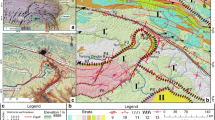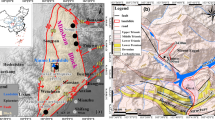Abstract
On June 24, 2017, a catastrophic landslide (Xinmo landslide) occurred on the left bank of Songping river in Diexi town, Sichuan Province, China. Based on field investigations, this paper tries to reveal the cause and mechanism of the initiation and development of the Xinmo landslide. Xinmo landslide is located in the so called “Minshan block.” This tectonic block is very active and generates many earthquakes. Among them, the 1933 Diexi Ms 7.5 earthquake which had an indispensable effect on the occurrence of the Xinmo landslide, whose distance to the recent Xinmo landslide is only 8.7 km. The 1933 earthquake triggered the collapse of the Qianxin gully, which damaged the rock mass forming the source of the Xinmo landslide and creating a free prominent ridge. The later 1976 Songpan Ms 7.2 earthquake and the 2008 Wenchuan Ms 8.0 earthquake further damaged the integrity of the rock mass in the source area of the 2017 Xinmo landslide. The Xinmo landslide developed on a typical bedding dip slope with metasandstone intercalated with a few thin bedded slate layers. The slate intercalation gives the slope a very low shear strength in the dip direction and the long term rainfall may have softened the slip zone and the locked section. These two aspects have promoted the occurrence of Xinmo landslide.















Similar content being viewed by others
References
Chen Z (1992) Motion transformation of high-locality landslide. J Mt Res 10(4):225–228
Chen XZ, Cui YF (2017) The formation of the Wulipo landslide and the resulting debris flow in Dujiangyan city, China. J Mt Sci 14(6):1100–1112. https://doi.org/10.1007/s11629-017-4392-1
Fan X, Xu Q, Scaringi G, Dai L, Li W, Dong X, Zhu X, Pei X, Dai K, Havenith HB (2017a) Failure mechanism and kinematics of the deadly June 24th 2017 Xinmo landslide, Maoxian, Sichuan, China. Landslides 3:1–18
Fan JR, Zhang XY, FH S, Ge YG, Tarolli P, Yang ZY, Zeng C, Zeng Z (2017b) Geometrical feature analysis and disaster assessment of the Xinmo landslide based on remote sensing data. J Mt Sci 14(9):1677–1688. https://doi.org/10.1007/s11629-017-4633-3
Huang R, Wang Z, Pei S, Wang Y (2009) Crustal ductile flow and its contribution to tectonic stress in Southwest China. Tectonophysics 473(3):476–489. https://doi.org/10.1016/j.tecto.2009.04.001
Huang R, Pei X, Fan X, Zhang W, Li S, Li B (2012) The characteristics and failure mechanism of the largest landslide triggered by the Wenchuan earthquake, May 12, 2008, China. Landslides 9(1):131–142. https://doi.org/10.1007/s10346-011-0276-6
Jones LM, Han W, Hauksson E, Jin A, Zhang Y, Luo Z (1984) Focal mechanisms and aftershock locations of the Songpan earthquakes of August 1976 in Sichuan, China. J Geophys Res 89(B9):7697–7708. https://doi.org/10.1029/JB089iB09p07697
Legros F (2002) The mobility of long-runout landslides. Eng Geol 63(3):301–331. https://doi.org/10.1016/S0013-7952(01)00090-4
Li Y, Cao S, Zhou RJ, Densmore AL, Ellis MA (2005) Late cenozoic Minjiang incision rate and its constraint on the uplift of the eastern margin of the Tibetan Plateau. Acta Geol Sin 79(1):28–37 (In Chinese with English abstract)
Ling S (2015) Landslide damming in Western Sichuan Province, China, with special reference to the 1786 Dadu River and 1933 Diexi events. M.Sc. Thesis, University of Waterloo, Ontario, Canada, 99 pp
Ouyang CJ, Zhao W, He SM, Wang DP, Zhou S, An HC, Wang ZW, Cheng DX (2017) Numerical modeling and dynamic analysis of the 2017 Xinmo landslide in Maoxian County, China. J Mt Sci 14(9):1701–1711. https://doi.org/10.1007/s11629-017-4613-7
Qian H, Zhou R, Ma SH, Li XG (1999) South segment of Minjiang fault and Diexi earthquake in 1933. Earthq Res China 15(4):333–338
Tang HM, Liu X, XL H, Griffiths DV (2015) Evaluation of landslide mechanisms characterized by highspeed mass ejection and long-run-out based on events following the Wenchuan earthquake. Eng Geol 194:12–24. https://doi.org/10.1016/j.enggeo.2015.01.004
Wang K, Shen Z (2011) Location and focal mechanism of the 1933 Diexi earthquake and its associated regional tectonics. Acta Seismol Sin 33(5):557–567 (In Chinese with English abstract)
Wang Y, Huang R, Luo Y, Xu H (2011) The genetic mechanism of wenchuan earthquake. J Mt Sci 8(2):336–344. https://doi.org/10.1007/s11629-011-2096-5
Wang Y, Luo Y, Wang F, Wang D, Ma X, Li S, Deng X (2012) Slope seismic response monitoring on the aftershocks of the wenchuan earthquake in the mianzhu section. J Mt Sci 9(04):523–528. https://doi.org/10.1007/s11629-012-2179-y
Xu X, Wang L (2005) On the mechanism of slope deformation-failures and their distribution characteristics in a high earthquake-intensity area. J Eng Geol 13(1):68–75 (In Chinese with English abstract)
Yamaguchi S, Ogawa Y, Fuji-Ta K, Ujihara N, Inokuchi H, Oshiman N (2010) Audio-frequency magnetotelluric imaging of the hijima fault, yamasaki fault system, southwest japan. Earth Planets Space 62(4):401–411. https://doi.org/10.5047/eps.2009.12.007
Yang Q (2003) The study on the stability of high landslide of Tianlonghu hydropower station. Sichuan Water Power 22(2):66–68 (In Chinese)
Yin Y, Cheng Y, Liang J, Wang W (2016) Heavy-rainfall-induced catastrophic rockslidedebris flow at Sanxicun, Dujiangyan, after the Wenchuan Ms 8.0 earthquake. Landslides 13(1):9–23. https://doi.org/10.1007/s10346-015-0554-9
Zhang HP, Zhang PA, Zhang W, Zhang HB (2004) Dem-based simulation on structural geomorphic of Minjiang fault zone. J Liaoning Tech Univ 23(5):603–605 (In Chinese with English abstract)
Zhang YQ, Yang N, Meng H (2005) Deep-incised valleys along the Minjiang river upstream and their responses to the uplift of the west Sichuan Plateau, China. J Chengdu Univ Technol 32(4):331–340 (In Chinese with English abstract)
Zhong B, Nie DX (2003) Computing joint persistence ratio and strength of rock mass by using rock discontinuity network simulation. Chin J Geol Hazard Control 14(2):90–93 (In Chinese with English abstract)
Acknowledgements
The authors express their gratitude for the financial assistance. We thank Professor Xu Qiang, Pei Xiangjun, Ren Guangming for very useful photos, and Manager Gong Ziqiang for the field investigations. We also thank Prof. Theo van Asch for his linguistic assistance during the preparation of this manuscript, and thank the Handing Editor (Jia-Jyun Dong) and the two anonymous reviewers for their constructive comments and suggestions which greatly improved the quality of the manuscript.
Funding
This study has been supported by the National Natural Science Foundation of China (41521002) and the Open Fund of the State Key Laboratory of Geohazard Prevention and Geoenvironmental Protection (Chengdu University of Technology) (SKLGP2015Z001).
Author information
Authors and Affiliations
Corresponding author
Appendix A. The calculation method of the connectivity of rock mass
Appendix A. The calculation method of the connectivity of rock mass
Brandwidth projection method is adopted to calculate the connectivity of rock mass. Brandwidth projection method mainly refers to the proportion of effective fractures along a certain shear direction in effective statistical region (Zhong and Nie 2003), as shown in Fig. 16. The corresponding mathematical expressions are as follows:
Where Total length is the length of base line, Total Projection Line is the sum of Projection Lines, Projection Line is the length of the projection from the fractures to the base line and the specific projection method can refer to Fig. 16.
Rights and permissions
About this article
Cite this article
Wang, Y., Zhao, B. & Li, J. Mechanism of the catastrophic June 2017 landslide at Xinmo Village, Songping River, Sichuan Province, China. Landslides 15, 333–345 (2018). https://doi.org/10.1007/s10346-017-0927-3
Received:
Accepted:
Published:
Issue Date:
DOI: https://doi.org/10.1007/s10346-017-0927-3





